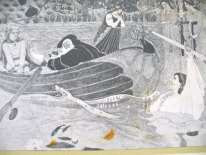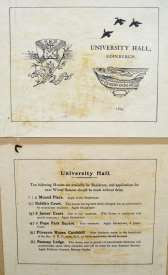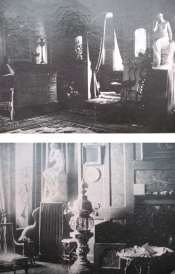GEDDES IN EDINBURGH
Geddes arrived in Edinburgh in 1884 by way of London, Roscoff, Paris, Naples, Mexico and Ireland. He was thirty years old.
Edinburgh had not grown by a continuous process, but rather by a series of great efforts, followed by a period of adjustment hardly completed before the next crisis.
Living conditions in the Old Town had deteriorated, aggravated by the great fire of 1824, the great depression in the 1860s and the industrial crisis of 1884-90.
There were some ineffectual attempts by the Council to make improvements. A notable exception was the work of Lord Provost Chambers.

Geddes travelled extensively around the world but always returned to the Old Town of Edinburgh, where he worked out many of his ideas.
At Ramsay Gardens he had flats built to lure back to the city centre a mix of professional people. At Riddles Court he ran Summer Schools and established the first self-governing students’ hostel in Europe. The Outlook Tower was set up as a centre for studying Edinburgh in its regional context. Areas of waste ground were turned into urban gardens.
CONSERVATIVE SURGERY
When Geddes and his wife Anna moved into James Court in Edinburgh, the Lawnmarket had long since declined from an area of town mansions to one of the worst slums in the city. The tenements, which were unsanitary and overcrowded, focused Geddes’ ideas about social reform firmly on the practicalities of housing conditions. Having furnished their own flat, they began a series of simple improvements to the buildings: cleaning, whitewashing, installing window boxes and the like, while at the same time encouraging closer co-operation between their neighbours to create a sense of community. “Civic Regeneration” was how he described this policy and he coined the term “conservative surgery” to describe it in practice, preferring to clear away useless, unwanted buildings rather than demolish and rebuild. Housing had evolved in relation to the life of the neighbourhood and should be preserved where possible by relieving the congestion and breathing new life into the area. To further these aims the Environment Society was formed which grew into the Edinburgh Social Union as their activities expanded to take in several other buildings. This was one of the most hectic and productive periods of Geddes’ career and he embarked on a series of ventures within this organisation which dominated his later work. Open spaces in the city centre were cleared and planted to create gardens, concerts were given, an art school was set up to emphasize the social role of art in public mural decoration, the University Extension offered classes to the public leading into the annual International Summer Meetings and the first of several student hostels was founded in the old town. The culmination of this period came in 1891 when Geddes purchased the old “goose pie” house of the 18th century poet Allan Ramsay. Over the next three years he remodelled and extended the original house into the complex of buildings now called Ramsay Gardens.

University Promotion 
Ramsay Gardens
GARDEN NETWORK IN THE OLD TOWN
In the derelict spaces left in the Old Town by wholesale demolition of the late nineteenth century, he created a network of gardens to be cultivated by school children.
He had envisaged about 75 such gardens up and down the High Street measuring about ten acres in all, according to a map by the Open Spaces Committee, led by Frank Mears, and enthusiastically helped by Mabel Barker and his children Alastair and Norah.
In the Transactions of the Cities and Town Planning Exhibition prepared by Patrick Geddes at the Royal Scottish Academy in Edinburgh in 1911, 10 or 12 had been already reclaimed into gardens in the Old Town, others were in preparation. Now in 2007, only a few are still extant.
1. Johnston Terrace Wildlife Garden, off the Patrick Geddes Steps, adjacent to 25 Johnston Terrace, where the children of the Castlehill School spent many days in the newly created garden cultivating small plots of land and learning about nature by direct experience. Now it is a wildlife garden managed by the Scottish Wildlife Trust.
2. Granny’s Green Garden, now restored, was formerly called King’s Stables Road Garden in the Geddes’ survey.
3. Dunbar’s Close Garden, next to the Canongate Church on the north side. It was restored in 1977 in the style of a 17th century town garden.
4. Chessel’s Court Garden, 6b Chessels Court, Canongate. The garden was created out of the rubble of demolished old buildings. It is approached by a communal garden.
5. Boswell’s Garden. 4/1 Chessels Court, Canongate. James Boswell spent half of his married life here. Latterly the play area of St. Savior’s Child Garden
6. West Port Garden. At one time used by a Scout group but is now under the care of a local residents’ group.
7. Scottish Book Trust Garden. An award-winning garden behind John Knox’s house and Moubray House in the Royal Mile, which now houses a bust of Geddes. It is accessed from Trunks Close. The Sandeman House Garden is an example of a contemporary landscape. It is a developed inner court within the Old Town of Edinburgh. The layout of the garden is formal. The Monument is set within a cultivated section of the garden forming a composition of groundscape, trees, lawn, steps and terrace.
The garden was redesigned in 1996 in a joint venture between the owner (a landscape architect) and the Lothian and Edinburgh Enterprise Ltd. In her book, Hidden Gardens of the Royal Mile, Jean Bareham says that the “design is strong and creates a completely different feel to what has been a fairly non-descript piece of land”.
The garden is on the Geddes Heritage Trail and the Hidden Gardens Trail. It is in private ownership for public use and is used by the local community and visitors. It is one of a number of cultural facilities, such as the Scottish Storytelling Centre, in the Netherbow. The Monument increases the sense of place for community use and personal contemplation, as well as prompting thought.
8. White Horse Close. It used to be the terminus for the London coach at the bottom of the Royal Mile.
“Despite all that is commonly said about rough population and the rest, no mischief worth mentioning is ever done. Quite the contrary, the gardens are thoroughly appreciated, and their educating, civilising influence already plain is spreading in ways too varied and complex for consideration here.”
From: Geddes: Transactions of the Cities and Town Planning Exhibition. Edinburgh. 1911.
